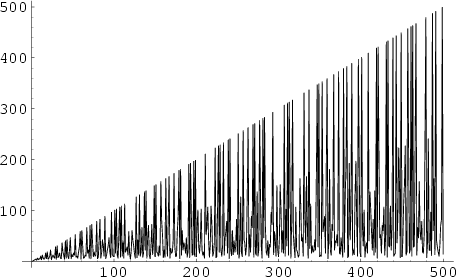|
|
|

The smallest value ![]() for a given
for a given ![]() for which
for which ![]() (
(![]() divides
divides ![]() Factorial). For example, the number
8 does not divide
Factorial). For example, the number
8 does not divide ![]() ,
, ![]() ,
, ![]() , but does divide
, but does divide
![]() , so
, so ![]() . For a Prime
. For a Prime ![]() ,
,
![]() , and for an Even Perfect Number
, and for an Even Perfect Number ![]() ,
, ![]() is Prime (Ashbacher 1997).
is Prime (Ashbacher 1997).
The Smarandache numbers for ![]() , 2, ... are 1, 2, 3, 4, 5, 3, 7, 4, 6, 5, 11, ... (Sloane's A002034). Letting
, 2, ... are 1, 2, 3, 4, 5, 3, 7, 4, 6, 5, 11, ... (Sloane's A002034). Letting ![]() denote the smallest value of
denote the smallest value of ![]() for which
for which ![]() , 2, ..., then
, 2, ..., then ![]() is given by 1, 2, 3, 4, 5, 9, 7, 32, 27, 25, 11,
243, ... (Sloane's A046021). Some values of
is given by 1, 2, 3, 4, 5, 9, 7, 32, 27, 25, 11,
243, ... (Sloane's A046021). Some values of ![]() first occur only for very large
first occur only for very large ![]() , for example,
, for example, ![]() ,
,
![]() ,
,
![]() ,
,
![]() , and
, and
![]() . D. Wilson points out that if we let
. D. Wilson points out that if we let
The incrementally largest values of ![]() are 1, 2, 3, 4, 5, 7, 11, 13, 17, 19, 23, 29, ... (Sloane's A046022), which occur
for
are 1, 2, 3, 4, 5, 7, 11, 13, 17, 19, 23, 29, ... (Sloane's A046022), which occur
for ![]() , 2, 3, 4, 5, 7, 11, 13, 17, 19, 23, 29, ... (Sloane's A046023), i.e., the values where
, 2, 3, 4, 5, 7, 11, 13, 17, 19, 23, 29, ... (Sloane's A046023), i.e., the values where ![]() .
.
Tutescu (1996) conjectures that the Diophantine Equation ![]() has no solution.
has no solution.
See also Factorial, Greatest Prime Factor, Pseudosmarandache Function, Smarandache Ceil Function, Smarandache Constants, Smarandache-Kurepa Function, Smarandache Near-to-Primorial Function, Smarandache-Wagstaff Function
References
Ashbacher, C. An Introduction to the Smarandache Function. Cedar Rapids, IA: Decisionmark, 1995.
Ashbacher, C. ``Problem 4616.'' School Sci. Math. 97, 221, 1997.
Begay, A. ``Smarandache Ceil Functions.'' Bulletin Pure Appl. Sci. India 16E, 227-229, 1997.
Dumitrescu, C. and Seleacu, V. The Smarandache Function. Vail, AZ: Erhus University Press, 1996.
``Functions in Number Theory.''
http://www.gallup.unm.edu/~smarandache/FUNCT1.TXT.
Ibstedt, H. Surfing on the Ocean of Numbers--A Few Smarandache Notions and Similar Topics.
Lupton, AZ: Erhus University Press, pp. 27-30, 1997.
Sandor, J. ``On Certain Inequalities Involving the Smarandache Function.'' Abstracts of Papers Presented to the Amer. Math. Soc.
17, 583, 1996.
Sloane, N. J. A. Sequences
A046021,
A046022,
A046023, and
A002034/M0453
in ``An On-Line Version of the Encyclopedia of Integer Sequences.''
http://www.research.att.com/~njas/sequences/eisonline.html.
Smarandache, F. Collected Papers, Vol. 1. Bucharest, Romania: Tempus, 1996.
Smarandache, F. Collected Papers, Vol. 2. Kishinev, Moldova: Kishinev University Press, 1997.
Tutescu, L. ``On a Conjecture Concerning the Smarandache Function.'' Abstracts of Papers Presented to the Amer. Math. Soc.
17, 583, 1996.
|
|
|
© 1996-9 Eric W. Weisstein